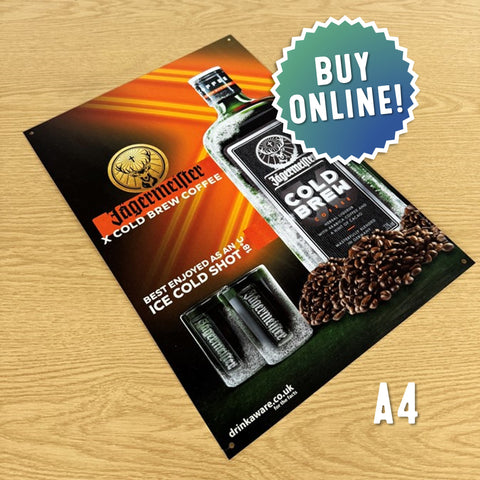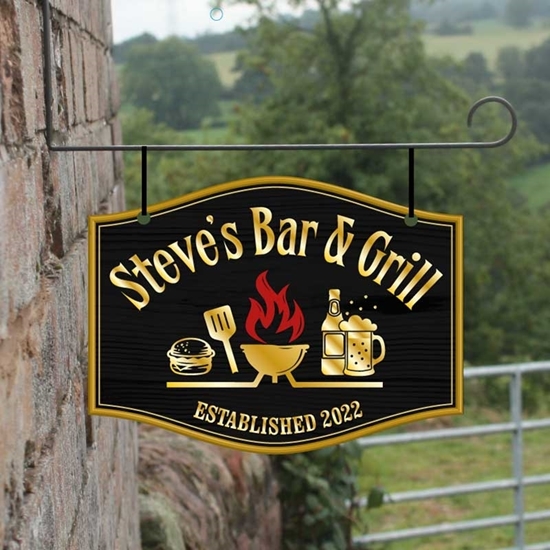Free Facts For Selecting Gin Bar Signs
Free Facts For Selecting Gin Bar Signs
Blog Article
What Size Differences Are There Between Bar Signs And Other Signs For Bars?
According to their intended use as well as their design aesthetics, location and Bar signs vary in terms of size. Here's how different sizes can influence bar signs with regard to their functionality and appearance. Large Signs
The purpose of the Arrow is to draw the attention of others and serve as a focal point.
It can be used for exterior signage, primary branding or feature walls.
Placement: They are typically set up on walls or other large areas outside the bar to draw customers.
Examples include neon signs with large sizes with a vintage look big-sized murals, and vintage-style signs that are large in size.
2. Medium Signs
The purpose is to add information, or enhance the look of the room without taking up excessive space.
Menu boards, promotional displays and directional signs.
Placement: Positioned in a way that's easily visible but not overwhelming. For instance, behind the bar, over seating areas, or on walls with feature features.
For instance chalkboards of medium size with daily specials or metal signs with the bar's logo.
3. Small Signs
Purpose: To offer specific information or to add subtle ornamental elements.
Uses: Table signs, small decorative pieces, or labels.
Placement: On tables shelves, tables, or in display cases where close-up view is required.
Examples: Small-framed quotes or drink cards.
Size Considerations
Visibility
Large Signs: They are designed to be visible from a distance, making them perfect for attracting the attention of passers-by as well as establishing the bar's presence.
Medium Signs: They balance the need for information and space efficiency. They do this without overwhelming decor.
Small Signs are best for information at close range and intimate specifics. This can enhance the customer experience.
Proportion
The size of the signs should be in proportion to the space to avoid overwhelming small areas. These signs are best designed for large and open areas.
Medium Signs: They work well in many interior spaces, allowing versatility in placement.
Smaller signs: Ideal to add details and to fit into smaller spaces with less clutter.
Impact
Signs in large sizes: These signs can create an impression that is striking and could become a crucial branding element. It is used to establish the mood of the bar.
Medium Signs are a good combination of design and the glare. They help create an enjoyable atmosphere as well as conveying important messages.
Small Signs (Signs) are a great way to add detail and a sense of humour to a visual experience.
Practicality
Large Signs: Need massive mounting solutions, and could be more costly because of the size and material.
Medium Signs: Simple to set up and move around, offering flexibility in designs changes.
Small Signs: Highly versatile and simple to change or update suitable for dynamic environments like bars that change menus or promotions.
Functionality
Large Signs: They are used primarily for visibility and appeal.
Medium Signs: They're both decorative and functional. They provide essential information while also adding aesthetics.
Small Signs: Primarily functional to provide information in a clear manner, they contribute to the overall theme and style with a subtle approach.
Choosing the right size for signs at bars is dependent on the purpose they are intended to serve as well as the design of the space and the intended impact on customers. Balancing these elements ensures that the signs contribute effectively to the ambience of the bar as well as operational needs. Check out the recommended straight from the source on hanging pub signs for more examples including home bar pub signs, personalised sign for bar, personalised cocktail bar sign, bar sign outdoor, personalised bar signs, personalised beer sign, to the bar sign, outdoor home bar signs, personalised bar signs, personalised hanging pub signs and more.
What Are The Differences Between Bar Signs With Regard To Lighting?
The bar signs differ greatly in regards to lighting, which impacts their ambiance, visibility, as well as their overall impression. Here are some key ways lighting influences bar signs. Neon Signs
Characteristics: Bright, colorful, classic.
Lighting Neon gas-filled tubes release lights when they are charged electrically.
Uses : Great for creating an old-fashioned, retro style. Useful for logos and bar names.
Benefits: It's very visible from an extended distance.
The material is delicate and costly to repair.
2. LED Signs
Characteristics: Energy-efficient, versatile, modern.
Lighting: Uses LEDs to produce powerful and bright lighting.
Uses: Suitable for both outdoor and indoor signs, programmable displays, and dynamic lighting effects.
Benefits: Energy efficient and long-lasting. The system can be programmed to change colors or animations.
Benefits: The initial cost may be expensive, but the savings on energy and maintenance are significant.
3. Backlit Signs
Characteristics: Elegant, sophisticated, subtle.
Lighting: Place LEDs, fluorescent lights or Halogen lamps on a transparent material to produce an ethereal light.
Applications: Used for modern bar signs, menu boards as well as branding elements.
Benefits: Increases the accessibility of small print in dim lighting conditions.
The disadvantages are the complexity of installation and higher cost upfront.
4. Signs Edge-Lit
Characteristics: Sleek, contemporary, stylish.
Lighting: Use LEDs to illuminate the edges of a sign usually acrylic.
Uses: Great for modern minimalist designs. Often used as informational or directional signs.
Advantages: Creates a sophisticated and distinct appearance. Energy efficient.
Disadvantages: Limited to specific design styles.
5. Ambient/Accent Lighting
Characteristics: Subtle, atmospheric, decorative.
Lighting: Utilizes indirect sources of light to highlight and accentuate signage.
Uses Improves the ambience. It is often used to showcase artwork or theme decor.
Benefits: Creates an atmosphere that is warm and inviting.
Advantages: Direct illumination might not be enough for reading.
6. Marquee signs
Characteristics: Bold, theatrical, eye-catching.
Lighting: Use a variety of lights or LEDs around the edges of the sign.
Uses: Popular as exterior signage, for event promotion and to give a vintage look.
Benefits: High visibility and attention-grabbing.
Some disadvantages include high costs and frequent maintenance.
7. Projection Signs
Characteristics: Dynamic, innovative, versatile.
Lighting: Projectors are used to project light and images on the surface.
Applications: Can be used for events and promotions that are only temporary.
Advantages: Easy to alter and there is no structure is needed.
Disadvantages: Requires a controlled lighting environment, and can be less effective in bright lighting.
8. Fluorescent Signs
Characteristics: Bright, cost-effective, traditional.
Lighting: Utilizes fluorescent tubes to provide illumination.
Typically, these are placed for large outdoor and indoor signs.
Benefits: Bright, efficient and inexpensive for large signs.
Disadvantages : They are less efficient in terms of energy efficiency than LEDs and can produce an unnatural lighting.
Considerations for Lighting
Visibility
Neon-colored LEDs and signs are great for attracting people's attention, especially in dim lighting conditions.
Backlit and Edge-Lit Signs can be used to improve the readability of signs and achieving the appearance of polished.
Energy Efficiency
LED Signs are energy efficient. They can also last for a long time.
Fluorescent and neon Signs: more energy efficient, while neon is more delicate.
Aesthetic Appeal
Neon signs and marquees work well for vintage and retro aesthetics.
Backlit and Edge-Lit Signs Ideal for contemporary, sleek designs.
Ambient Lighting: Improves the overall ambience and atmosphere.
Maintenance
LED signs are low maintenance and last for a long time.
Signs with fluorescent or neon lights may require more frequent maintenance and repairs.
Cost
Backlit and LED signs Costs of initial investment, but less operational expenses.
Fluorescent signs are more affordable initially, but they use more energy in the long-term.
Flexibility
Projection and Programmable LED Signs: Offer high flexibility for moving displays and dynamic content.
Traditional Signs: More rigid but often provide a specific preferred look.
When choosing the best type of lighting for signs at bars bar owners can improve their establishment's visibility, create the desired atmosphere and effectively promote their business's image and promotion to customers. Have a look at the most popular their explanation on pub signs for site advice including bar sign hanging, outdoor home bar signs, hanging pub signs, bar wall signs, pub signs made, hanging pub signs, outdoor personalised bar sign, bar sign outdoor, home bar pub signs, pub bar signs for sale and more.
What Is The Difference Between Bar Signs And Branding?
Bar signs play an important role in branding. They convey to clients the company's personality, style and the identity of the business. What are the distinctions between logos and bar signs? Logo and Brand Identity
Logo integration: Integrating prominently the bar's name in the signage helps to reinforce the establishment's identity and brand recognition.
Consistent branding: Signs need to match with other branding elements such as menus or coasters.
2. Design and visual style
Thematic Design - Signs reflecting the overall theme of the bar.
Custom Graphics. Typography, graphics and images are unique and help to differentiate of an individual brand.
3. Color Scheme
Branded Colors: Using the colors of the bar's brand in signage helps to reinforce the brand's recognition and creates a cohesive visual brand identity.
Color Contrasts and Legibility It is important to select colors that are both consistency with the brand as well as the ability to be read in various lighting conditions.
4. Tone and Communication
Brand voice: Signs may communicate a bar's personality or tone, be it playful and lighthearted elegant and refined, or even edgy.
Taglines and Slogans catchy slogans or taglines can help reinforce the message of the brand and leave a lasting impression on the customers.
5. Placement and Visibility
Signage placement: The signs are strategically placed to maximize their visibility, either at the entry point, in the bar, or the entire venue.
Size and Scale: Larger signs command the attention of others and make a striking statement, while smaller signs offer subtle branding cues in more intimate areas.
6. Specialty Signage
Signature Signs - Customized signs such as chalkboard menus, neon signs and chalkboards give your business a unique look while promoting your brand.
Interactive Elements: Signs that incorporate interactive elements like QR codes or digital menus, enhance the experience of patrons as well as increasing brand recognition.
7. Brand Storytelling
Signs that include historical aspects like the place of the bar or the founder or the name of its founder, can provide a feeling of authenticity among customers.
Signage that highlights special promotions and signature cocktails as well as unique amenities reinforces the appeal of a bar, and also encourages patronage.
8. Promotional branding and seasonal branding
Themes for the Holiday Season: Holiday decorations and themed signs show the festive spirit of the bar and create a memorable experience for patrons.
Signs that promote special events, happy hours or special offers for a limited time can increase brand awareness and sales.
9. Customer Engagement
User-Generated Materials: Encouraging patrons to upload photos of your signage onto social media platforms can enable you to reach a broader audience and build a stronger sense of community.
Interactive Signage: Signs which allow patrons to participate, like chalkboards to draw on or photo booths where customers can capture selfies are memorable and help build brand loyalty.
10. Digital Branding
Digital Signage. Interactive displays or LED screens are a great way to create dynamic branding providing real-time updates to content Animations, multimedia and other.
Online Presence QR Codes and Social Media handles on signage increase online engagement and connect customers with the bar’s digital presence. This reinforces brand visibility and accessibility.
Bar owners can use signs to promote their brand's identity and attract customers, as well as make their establishments stand out in a highly competitive market. Take a look at the most popular over at this website on hanging pub signs for site advice including personalised signs for home bar, bar signs, make a pub sign, pub signs, bar wall signs, garden bar signs, personalised garden bar signs, signs for garden bar, personalised home pub sign, large pub sign and more.